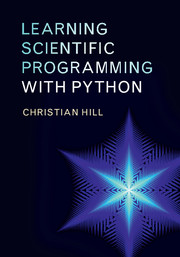
-
Select format
-
- Publisher:
- Cambridge University Press
- Publication date:
- February 2016
- February 2016
- ISBN:
- 9781139871754
- 9781107075412
- Dimensions:
- (247 x 174 mm)
- Weight & Pages:
- 0.93kg, 462 Pages
- Dimensions:
- Weight & Pages:
- Subjects:
- Physics and Astronomy, Mathematical Methods
You may already have access via personal or institutional login- Subjects:
- Physics and Astronomy, Mathematical Methods
Book description
Learn to master basic programming tasks from scratch with real-life scientifically relevant examples and solutions drawn from both science and engineering. Students and researchers at all levels are increasingly turning to the powerful Python programming language as an alternative to commercial packages and this fast-paced introduction moves from the basics to advanced concepts in one complete volume, enabling readers to quickly gain proficiency. Beginning with general programming concepts such as loops and functions within the core Python 3 language, and moving onto the NumPy, SciPy and Matplotlib libraries for numerical programming and data visualisation, this textbook also discusses the use of IPython notebooks to build rich-media, shareable documents for scientific analysis. Including a final chapter introducing challenging topics such as floating-point precision and algorithm stability, and with extensive online resources to support advanced study, this textbook represents a targeted package for students requiring a solid foundation in Python programming.
Reviews
'This book is well illustrated and is supported by an extensive collection of resources online in the book’s website, scipython.com. This site has code listings and solutions to exercises. I would readily recommend this book to any student (or even a colleague) who wishes to achieve a solid foundation in Python programming.'
Vasudevan Lakshminarayanan Source: Contemporary Physics
Contents
Metrics
Altmetric attention score
Full text views
Full text views help Loading metrics...
Loading metrics...
* Views captured on Cambridge Core between #date#. This data will be updated every 24 hours.
Usage data cannot currently be displayed.
Accessibility standard: Unknown
Why this information is here
This section outlines the accessibility features of this content - including support for screen readers, full keyboard navigation and high-contrast display options. This may not be relevant for you.
Accessibility Information
Accessibility compliance for the PDF of this book is currently unknown and may be updated in the future.


